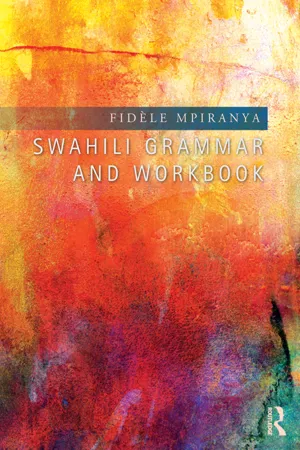
- 250 pages
- English
- ePUB (mobile friendly)
- Available on iOS & Android
Swahili Grammar and Workbook
About This Book
Swahili Grammar and Workbook provides a practical and comprehensive companion to Swahili grammar, filling in gaps left by other textbooks. Presenting the essentials of Swahili grammar in a highly accessible fashion, it reduces complex language topics to helpful rules and mnemonic aids, enabling maximum grammar retention and accurate usage. Grammar points are followed by multiple examples and exercises, allowing students to consolidate and practice their learning. No prior knowledge of linguistic terminology is required.
Key features include:
-
- Twenty five language notes covering key topics such as: personal pronouns; the Swahili noun class system; special class combinations; the imperative, the subjunctive, and the conditional moods; the use of comparatives; the use of monosyllabic verbs; the passive form and various other forms of verb extensions; the relative clause
- Clear, detailed and jargon-free grammatical explanations supported by an assortment of helpful diagrams, charts and tables and many relevant and up-to-date examples
- A wide range of communication-oriented exercises to reinforce learning and develop students' ability to use Swahili actively
- Audio files to support pronunciation practice, clearly linked to relevant sections of the book and available for free download at http://www.routledge.com/books/details/9781138808263/
- Four appendices, Swahili-English and English-Swahili vocabulary lists, a bibliography and an index presented at the back of the book for easy access to information.
Written by a highly experienced instructor, Swahili Grammar and Workbook will be an essential resource for all students and teachers of Swahili. It is suitable for use both as a companion reference text in language courses and as a standalone text in independent grammar classes.
Frequently asked questions
Information







Table of contents
- Cover
- Half Title
- Title Page
- Copyright Page
- Dedication
- Table of Contents
- List of illustrations
- Acknowledgments
- Abbreviations and conventional signs
- Introduction
- 1 Swahili – key elements
- 2 Using basic vocabulary and markers
- 3 Personal pronouns
- 4 Swahili noun class system
- 5 Noun/adjective and pronoun agreement
- 6 The indicative mood and main verb tenses
- 7 Verb “be”/“have” in the main clause
- 8 Special class combinations and the reflexive pronoun
- 9 Prefix/stem contact rules vs. invariable adjectives/pronouns
- 10 Relative clauses and the use of reference pronouns
- 11 Imperative and subjunctive moods
- 12 Monosyllabic verb stems and the stem augment ku-
- 13 Auxiliary verbs and the expression of complex tenses
- 14 Expressing comparison
- 15 The passive form of the verb
- 16 Locative agreement and coordinated noun agreement
- 17 The conditional mood
- 18 The causative extension of the verb
- 19 Reciprocal, stative, and applicative verb extensions
- 20 Adverbs in a broad sense
- 21 Adjectives in a broad sense
- 22 Noun formation and augmentative/diminutive processes
- 23 Reduced forms and special uses of various pronouns
- 24 Subjunctive vs. infinitive/indicative in coordinated and subordinate clauses
- 25 Double object constructions and the use of “object markers”
- Appendix A: Greetings and other polite expressions
- Appendix B: Class agreements with all types of adjectives and pronouns
- Appendix C: Clause connectors and other transition words
- Appendix D: Use of verb tenses in Swahili proverbs
- Vocabulary list
- References
- Index